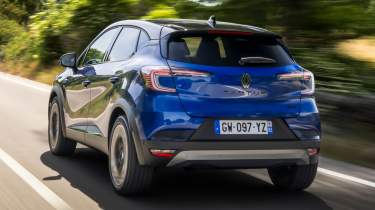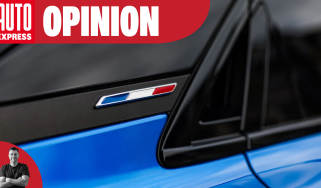New Renault Captur 2024 facelift review: stylish small SUV gets welcome updates
The Renault Captur SUV gets a sharper look and more kit as part of a 2024 facelift

Verdict
The small SUV field is very busy, but nearly every contender in the class forces some level of compromise, whether that’s in terms of space, performance or efficiency. With the Renault Captur, those compromises aren’t as great as they are for many of its rivals. And when you add in a super-competitive pricing strategy, it deserves to clean up the sector. Just like the Clio supermini, it feels upmarket inside, the tech is great to use and the performance is good enough while delivering great efficiency in everyday driving.
Renault is busy with new model launches in 2024. Cars such as the Rafale, Symbioz and revived Scenic have already made an impression, while the hotly anticipated 5 supermini and 4 crossover are coming later in the year. But Renault hasn’t forgotten its core line-up, and the Captur small SUV has been given the facelift treatment.
The updates are clear to see, with a new face for the car that has a more rugged appearance and brings it into line with the wave of new models. There’s the latest Renault logo on the nose, while the plastic trim across the front (the air intakes are set below in the front bumper), radiates out from the badge to the slender LED headlights. There are updated tail-lights (also LED), while the new top-spec Esprit Alpine trim level introduces 19-inch wheels to the range for the first time.
Used - available now

2022 Renault
Captur
19,338 milesManualPetrol1.0L
Cash £13,085
2022 Renault
Captur
50,442 milesManualPetrol1.3L
Cash £12,552
2022 Renault
Captur
14,602 milesAutomaticPetrol1.6L
Cash £15,999
2021 Renault
Captur
19,027 milesManualPetrol1.0L
Cash £13,400Under the skin, the dampers have been retuned to boost the car’s handling, while the Captur’s powertrains are carried over from the outgoing car. There’s a 99bhp 1.0 TCe turbo petrol, or the 1.6 E-Tech Hybrid we’re driving here.
Inside, the Captur has been given an even more thorough overhaul. All models are now fitted with a 10.4-inch portrait touchscreen that features Renault’s Google-powered infotainment system, and higher-spec cars come with Google Maps for navigation and a range of connected services. The system is the same as that found on the Clio – after all, the Captur shares the same platform and tech as the supermini – and the system is pretty easy to use. There are more than 50 voice commands on offer, while a wide range of apps are compatible with the system, too.
One welcome addition as part of the Captur’s update is a bank of toggle switches that sit below the main screen. These are used to operate the (standard fit) climate control, so you don’t need to go anywhere near the screen to adjust the cabin temperature.
Also included on the dashboard is a My Safety button, which can be configured to set the Captur’s safety systems as you like them. By default, all of the car’s assistance features – speed-limit warning, lane departure, forward-collision alert – activate every time you start the car. But one press of the My Safety button allows you to set your personalised safety settings before you drive away.
The cabin now features 26 per cent recycled fabrics in its construction, while leather is completely off the menu. This top-spec Esprit Alpine features a leather substitute that feels just like the real thing, while the seats themselves are comfortable and supportive. Overall quality inside is great, especially when you consider the Captur’s competitive pricing.
Cabin storage is decent up front – although we’ll have to wait and see if the left-hand-drive car’s large glovebox is carried over with the transition to right-hand drive UK cars – but given that the Captur’s dimensions are largely unchanged from the outgoing car’s, space in the rear remains a little compromised.
It’s not bad, but if you’re six-feet tall and sitting behind a driver of similar height, you might find legroom is a bit of a squeeze. There are cutouts in the front seat backs to mitigate this, but you wouldn’t want to sit there on a long journey.
Boot space is competitive for the class, though, and is helped by the Captur’s standard-fit sliding rear bench. There’s a maximum of 536 litres on offer with the seats fully forward, although the hybrid makes do with a maximum of 440 litres, courtesy of the 1.26kWh battery underneath the floor. Fold the seats flat, and the maximum capacity is 1,596 litres, or 1,458 litres for the hybrid.
Fire up the hybrid model, and much like any other car fitted with a petrol-electric powertrain, as long as there’s some charge in the battery, then you’ll just be greeted by a start-up beep to let you know that the Captur is ready to roll.
At lower speeds, the electric motor does a lot of the hard work, with the engine only cutting in if the battery voltage drops or you need a bit of extra acceleration. In fact, it’s the electric side of the powertrain that provides the best response, with the car’s 205Nm of torque generated by the electric motor on its own (the engine has 148Nm of torque). Renault estimates that the electric side of the Captur’s hybrid system will power the car for around 80 per cent of the time in urban driving, and from our experience that doesn’t seem far from the mark.
Light steering and a clear view of your surroundings work in your favour around town, while the car’s ride is reasonably compliant, even when fitted with the largest 19-inch wheels that come with Esprit Alpine trim.
Venture beyond the city streets, and the Captur offers decent driving manners. It’s competent more than engaging, but the balance between comfort and handling has been improved; and while the steering is quick, there’s not much feedback. There are different drive modes, with Comfort, Eco, Sport and Personal settings to choose from, but most of the time we found the Comfort setting to be perfectly acceptable.
Sport mode sees the engine running more of the time, but press on a little harder in the Captur and all that seems to happen is that there’s more noise from the powertrain. The four-cylinder unit revs higher, but it’s not a very tuneful unit, and its drone soon becomes tiresome.
Once you’re up to speed on the motorway, the Captur is a very quiet and refined machine. There’s little in the way of wind or road noise to be heard, while the main electric motor helps to give the car a boost when accelerating. Adaptive cruise control comes as standard on the Esprit Alpine, and this is able to operate in stop-start traffic, too.
Overall, the new Captur is a decent performer and the three-model range offers a lot of kit, especially when you consider the car is likely to kick off from around £21,000. That’s roughly £3,000 less than the starting price of the Peugeot 2008 or Volkswagen T-Cross, and nearly £5,000 less than for a Ford Puma.
Yet standard equipment is generous, with the base Evolution trim featuring the new touchscreen, 17-inch alloys, wireless phone charging and integration, a reversing camera and rear parking sensors, climate control, lane-keep assist and keyless entry and starting.
Mid-spec Techno adds a larger 10.25-inch digital driver’s display, a false boot floor, navigation, LED cabin lighting and the drive modes, while the Esprit Alpine boosts this with adaptive cruise control, a heated steering wheel and front seats, 19-inch alloys and two-tone paint.
| Model: | Renault Captur E-Tech Hybrid Esprit Alpine |
| Price | £28,000 (est.) |
| Powertrain: | 1.6-litre 4cyl hybrid |
| Power/torque: | 143bhp/205Nm |
| Transmission: | Six-speed automatic, front-wheel drive |
| 0-62mph: | 10.6 seconds |
| Top speed: | 106mph |
| Economy/CO2: | 60.1mpg/ 107g/km |
| Size (L/W/H): | 4,239/1,797/1,584mm |
| On sale: | Now |






